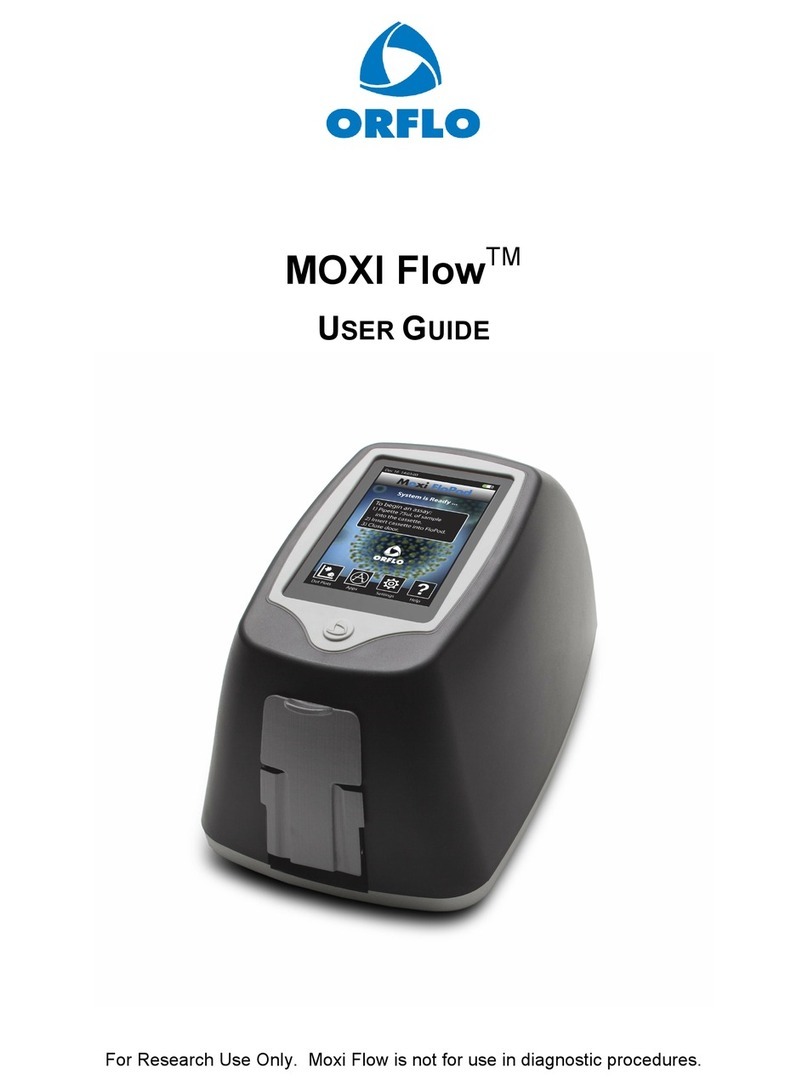This document is provided to customers who have purchased Orflo Technologies, LLC (“Orflo”) equipment, software,
reagents and consumables to use in the operation of such Orflo equipment, software, reagents, and consumables.
This document is copyright protected and any reproduction of this document in whole or any part is strictly prohibited,
except as Orflo may authorize in writing.
Limitations: The Moxi GO is intended for research use only. It is not intended for use in medical diagnostic or
therapeutic procedures, and it has not been approved or cleared by the Unites States Food and Drug Administration
for such uses.
Restrictions of Use: Software that may be described in this document is furnished under a license grant. Customer
shall not, nor shall it permit any third party to: (i) use, copy, modify, translate or adapt the Software or
Documentation.; (ii) rent, lease, share, disclose or transfer the Software, provide it on a subscription basis, or use it in
connection with a service bureau or other configuration whereby any third party may use the Software, (iii) create any
derivative works of or based on the Software or Documentation; (iv) reverse-engineer, decompile, disassemble or
otherwise attempt to discern the source code of the Software; (v) remove, relocate, alter or obscure any trademark,
copyright or other proprietary or restrictive marking or legend on the Software or Documentation or any copies
thereof; or (vi) use, provide or disclose the Software in violation of any applicable laws, orders or regulations.
Disclaimer: The information in this document is subject to change without notice and should not be construed as a
commitment by Orflo. Neither Orflo nor any of its affiliated corporations assumes responsibility for any errors that
may appear in this document. This manual is believed to be complete and accurate at the time of publication. In no
event shall Orflo or any of its affiliated corporations be liable for incidental or consequential damages in connection
with or arising from the use of this manual.
Trademarks: Portions of this document may make reference to other manufacturers and/or their products, which
may contain parts whose names are registered as trademarks and/or function as trademarks of their respective
owners. Any such usage is intended only to designate those manufacturer’s products as supplied by Orflo for
incorporation intio its equipment and does not imply any right or license to use or permit others to use such
manufacturer’ and or their product names as trademarks.
© 2016 E.I. Spectra LLC dba Orflo Technologies. All rights reserved.
Rev. 1.4, 03/2017
Orflo Technologies and Moxi GO™ are trademarks of E.I Spectra LLC dba Orflo Technologies, registered in the U.S.
and other countries.
Windows, Windows XP, Windows Vista, Windows 7, and Windows 8 are trademarks of Microsoft Corporation,
registered in the U.S. and other countries.
Mac and Mac OS are trademarks of Apple Corporation, registered in the U.S. and other countries.
FlowJo is a trademark of Treestar, Inc.
Flowmi™ is a registered trademark of SP Scienceware, Division of SP
Accutase®is a registered trademark of Innovative Cell Technologies.
TÜV SÜD and the TÜV SÜD symbol are registered trademarks of TÜV SÜD Aktiengesellschaft.




























